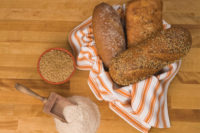It's that time of year—the most wonderful time of year. The time for family, friends and, of course, food. Thanksgiving has come and gone, and so have the leftovers. Now we’re in the throes of the holiday season with more gatherings every weekend.
A 2015 study by CPG sales and marketing firm Acosta found that 72 percent of consumers planned to host a holiday party. In addition to parties with friends, I have three more enormous family feasts to tackle: Christmas Eve, Christmas Day and New Year’s Eve. My next-door neighbors who celebrate Hanukkah have eight nights of family, storytelling and, of course, latkes, jelly doughnuts and brisket. My family is part of the unusual crowd that has dinner around 1:00 in the afternoon on holidays, taking a break to digest before having dessert later in the evening. It’s no wonder, being inundated with so much food, that the average person puts on about a pound during the holidays.
It’s easy to see why the most wonderful time of the year brings extra pounds: This is the season for indulging. Food is rightly served family-style, which leads to second and third helpings of massive portions, usually without even having to leave the table. And as we know, everything we eat matters. It may seem like a daunting task, but making good choices about what you eat during the holidays doesn’t have to be a struggle.
First, be smart about what you eat. Focus on variety, portion control and nutrition. Eat whole, fortified and fiber-rich grain foods. Make half your plate fruits and vegetables. When cooking, look for a lower-calorie option, like fat-free or low-fat milk and lean meats. There’s no shortage of recipe options during the holidays, so don’t be afraid to change things up.
Plan for family curveballs, like your cousin insisting that bread is unhealthy while simultaneously loading up on their third helping of potatoes. The challenge here is not the food itself, but the conversation surrounding it. Not only is bread a crucial party of any holiday meal, but grain foods pack a great nutrient-filled punch. All grain foods contributed less than five percent of total saturated fat and less than 15 percent of all calories in the total diet in 2009-2012 and in 2011-2014. At the same time, grain foods contribute a whopping amount of under-consumed shortfall nutrients and nutrients of public health concern, such as dietary fiber, folate, magnesium, calcium, iron, vitamin A, vitamin E, vitamin B12, niacin and thiamin. While you may not convince your cousin, it is important to manage your own inner nutrition messages. Many grain foods are nutritious staple products year-round, and this fact does not change during the holidays.
Finally, make sure you stay active. Make small changes like taking the stairs at the mall instead of the escalator. Go for a walk. Put the sweet potatoes in the oven, and do 30 minutes of yoga while you wait. If you live in a snowy area, take the family on a short hike through the winter wonderland between dinner and dessert.
Your healthful food choices during the holiday season may yield other benefits besides weight management: You might find your mind clearer and your stress reduced! Nutritious foods coupled with physical activity are sometimes all we need to feel just a little bit better. And as you know, it takes your “A” game to enjoy your family and the holiday. To your healthy appetite!




